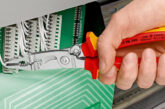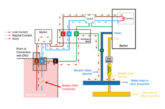
Provided you had a reliable test set, testing RCDs used to be pretty straightforward. Peter Wade of Megger looks at why life is now getting somewhat more complicated and discusses what you need to do about it.
Let’s start by revisiting a few basics. Residual current devices (RCDs) are available in numerous types but in domestic and commercial applications those you’re most likely to encounter are Type AC, Type A and Type B, so these are the types we’ll be discussing in this article.
So, what’s the difference between them?
Type AC RCDs are designed to protect circuits carrying AC currents with a sinusoidal waveform. Type A RCDs can also protect these circuits, but in addition they can protect circuits with currents that don’t have a sinusoidal waveform, such as pulsed DC or half-wave rectified AC. Finally, Type B RCDs can protect all the circuits that can be protected by Type AC and Type A devices, but they can also protect circuits carrying pure DC.
Until recently, the most commonly used type, certainly in domestic installations, was Type AC. This was entirely logical because in “the good old days” domestic equipment like washing machines, cookers and incandescent lights took a near-enough sinusoidal current from the supply, so all that was needed was an RCD that would protect circuits carrying currents with a sinusoidal waveform. And that was a Type AC RCD.
However, things have moved on. Many domestic loads – even apparently simple things like lighting – now have some form of electronic control, which means that the current they draw is no longer sinusoidal.
As a result of this, the familiar Type AC RCD is not appropriate to provide protection. In most cases, what’s needed is a Type A device but, in some applications such as EV chargers where DC may be present, a Type B RCD could be needed.
In response to these developments, some RCD manufacturers have stopped producing Type AC RCDs. After all, a Type A device costs more-or-less the same to manufacture and can provide all of the protection a Type AC device provides, so why have two different products? Just use a Type A everywhere you would previously have used a Type AC. That’s a perfectly acceptable thing to do and this change is likely to be enshrined in a forthcoming revision of the IET wiring regulations. It does, however, create a few headaches when it comes to testing!
Test the RCD for its purpose
Let’s consider the following scenario: you’re using a Type A RCD to do the job of a Type AC RCD, so how do you set up your RCD tester? Do you set it for testing a Type AC device or a Type A device?
It may seem obvious that, as it’s a Type A device, you should test it as such. Unfortunately, this may be incorrect. No matter what type of RCD you’re using, if you’re using it to do the job of a Type AC device, you should test it as if it were a Type AC device. In other words, test the RCD for the purpose for which it was fitted, not according to its type.
This does mean, however, that you – as the person carrying out the test – have to make a decision. What is the purpose for which the RCD is fitted?
If you’re confident that it is fitted to protect a circuit carrying only sinusoidal AC currents, test it as a Type AC. If, on the other hand, you think the circuit will carry only non-sinusoidal currents, test it as a Type A. And what if you’re not sure?
In that case, the only sound advice is to carry out the test sequence twice – once testing the device as Type AC and again testing it as Type A. Yes, it’s double the work but it’s the only way you can be sure that the RCD will operate correctly under all conditions.
What will ‘B
Up until now we’ve said little about Type B RCDs. These could, of course, be fitted in all applications as they will do the job of Type AC and Type A devices perfectly well. That’s not likely to happen though, because they are more expensive. So, Type B devices will typically be used only where there’s a possibility of pure DC flowing in the circuit that’s being protected.
Does this mean it’s safe to test them only as Type B devices? If you’re absolutely certain that there will only ever be DC current in the circuit, the answer is yes. But if there could be non-sinusoidal currents (pulsed DC, half-wave rectified AC and so on), you will also need to test them as Type A devices.
And if there is the possibility of sinusoidal AC currents, you’ll need to test them as Type AC as well. In other words, you may need to carry out three separate test sequences on Type B RCDs.
Only you can make the final decision, based on your knowledge of the application and the requirements of the wiring regs. There’s always a price to be paid for progress. Part of the price for our progress toward electronic control for household gadgets along with the growing adoption of EVs is that it’s getting more complicated to provide effective RCD protection in electrical installations.
This means testing that protection is also a little more complicated, but hopefully this article has provided some useful guidance.
To browse Megger’s full range of test equipment click here









